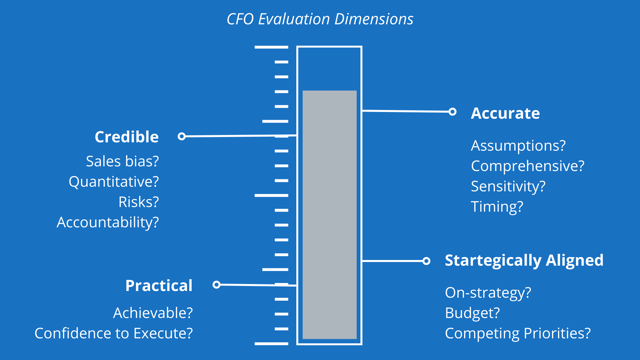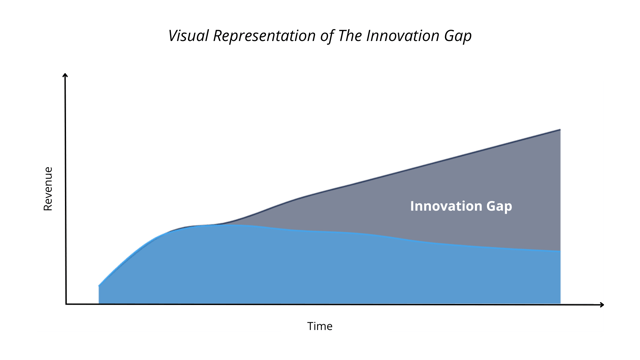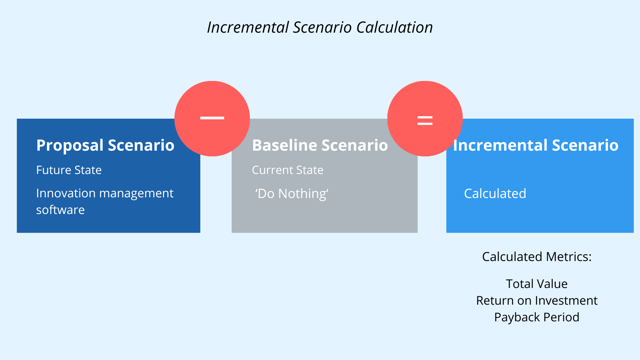A practical guide to quantifying the value of innovation management platforms.
Why Do You Need a Business Case?
As part of the process of bringing an innovation management platform to your company, you’ll likely be asked (if not required!) to build a business case to justify the investment. After all, budget holders (particularly CFOs) have numerous initiatives to evaluate but only a limited budget to allocate. Difficult decisions must be made. Presenting a well-constructed value story in the form of a business case is a great way to ensure you communicate the merits of your initiative.
Usually, CFOs evaluate business cases (of any type) across 4 different dimensions:
- Strategic alignment;
- Credibility;
- Accuracy;
- Practical value.

Source: Qarar
By covering each of these dimensions in your business case, you’ll:
- Boost your professional credibility, by speaking the language of the CFO
- Get the decision faster, by eliminating objections and revisions, and reducing meetings
- Ensure that the initiative is fully aligned with the overall business strategy
We’ll refer to each of these as we discuss how to build a business case for an innovation management platform.
Introducing The “Innovation Gap” Concept
The case for an innovation management platform like HYPE Innovation starts by first understanding the case for innovation broadly at your company – from the C-suite’s perspective.

Source: Qarar
The concept of the "innovation gap" refers to the divergence between the declining returns of existing products or services and the potential revenue growth that can be generated through innovation:
Declining returns over time: Every product, service, or technology has a lifecycle. Initially, when a product is introduced, there might be high demand and growth, especially if it's novel and meets a pressing need. However, as time progresses, several things can happen:- Market saturation: Almost everyone who wants the product already has it
- Competition: Other companies introduce similar or better products
- Technological advancements: What was once cutting-edge becomes outdated
- Changing customer preferences: What was popular or essential at one time might fall out of favor
As a result, revenues from that product or service start to decline.
- Innovation as a solution: To compensate for this natural decline and to continue growing, companies need to innovate. And the good news is that many types of innovation can help. Some examples include:
- Product innovation: Introducing new products or significantly upgrading existing ones
- Process innovation: Finding more efficient or cost-effective ways to produce and deliver products
- Business model innovation: Finding new ways to monetize, perhaps by changing the way customers pay or by finding new revenue streams
- Market innovation: Entering new geographical markets or targeting new customer segments
By innovating, companies can improve or add revenue streams that offset the decline of their older ones, effectively closing the innovation gap.
In essence, the innovation gap captures the ongoing challenge faced by businesses: the need to continuously evolve and adapt in the face of declining revenues from existing sources. By understanding this gap and effectively navigating it, companies can sustain their growth and stay competitive in the long run.
Closing The Innovation Gap at Your Company
If you’re reading this, whether you’re on a dedicated innovation team or not, you’re likely responsible for helping close the innovation gap. So you’ll be fully aware that innovating is easier said than done because it carries many risks. Here are some of the most common challenges and barriers when seeking to close the innovation gap:
- High costs: Research and development (R&D) can be expensive
- Uncertain returns: Not every innovation will be a hit in the market
- Organizational inertia: Established companies often have deep-rooted cultures and systems that resist change
- Market dynamics: Even if a company innovates, there's no guarantee that external factors (e.g., regulatory changes, economic downturns) won't impact its success
As a starting point, think about what key performance indicators matter to your business. Your leadership team may set targets on what you or your team needs to achieve in a certain amount of time. For some teams, this may not be explicitly communicated. However, to boost your business case, it’s a good idea to align yourself to an existing target.
Examples include:
- Revenue increase;
- Margin increase;
- Cost reduction;
- Risk reduction;
- Brand awareness;
- Employee engagement;
- Sustainability;
- Customer satisfaction.
Each of these targets might be broken down by a particular market, segment, or other categorization specific to your company and situation.
Companies can be innovating from a position of relative strength or a position of relative urgency. It’s important to know which category your company falls into, as this plays into how you tell your particular value story, referencing the strategic initiatives and targets along the way.
Step-by-Step Process for Creating The Perfect Business Case
Now that you know what you need to do (close the innovation gap), you need to figure out how you’re going to achieve it using an innovation management platform.
This is the basis of your business case – and it can be summarized as:
By implementing [selected Innovation Management Platform], [our team] can close the innovation gap [more effectively and faster] to achieve our goals of [insert strategic alignment and target metric].
In the current state, without [selected Innovation Management Platform], we wouldn’t be able to achieve the same results in the same amount of time.
While this is a great starting point, we need to prove it quantitatively – otherwise, it won’t pass the decision-maker's scrutiny.
In other words, we need a way to quantify that implementing and using the innovation management platform (our proposal) is a lot better than our current state solution (or baseline). We can calculate the difference between those scenarios (i.e., incremental value) to show the strength of the idea. Metrics like return on investment (ROI) and payback period that the decision maker (like a CFO) is interested in can be calculated based on those values to compare against other ideas competing for the same budget.

Source: Qarar
Step 1: Quantifying The Benefits of an Innovation Management Platform
Let’s put together a model of how a typical organization thinks about realizing its innovation goals through innovation projects or initiatives that get executed across the company.
The sum of all the innovation projects makes up the innovation portfolio.
Each innovation project or initiative has certain properties associated with it:
- Value of the project: What’s the incremental value (revenue, cost savings, etc.) that each project on average returns?
- Probability of success: Not all projects are successful. What’s the average success rate of an innovation project at your company?
Multiplying the number of innovative projects, the average value of a project, and the average probability of success gives you a measure of the total value of the innovation portfolio. This is your baseline (or current state) for innovation at your company.
Ask yourself: Is the value of your innovation portfolio enough to close the innovation gap?
For most companies, the answer is no. If the answer is yes, you may be making a case to continue to innovate from a position of strength. Even better.
There are three simple solutions to boosting the value of your innovation portfolio:
- Increase the number of innovation projects in your portfolio (i.e., get more ideas)
- Increase the value of each innovation project (i.e., get better-quality ideas that have higher value per project)
- Increase the probability of success of each project (i.e., mitigate the risk to achieving the full value of the project by, for instance, ensuring you have the right talent in place)
If you can assign a value (assumption) to how much your selected innovation management platform will improve those three properties of the portfolio, you can use it to calculate the future state value of the innovation portfolio.
Step 2: Quantifying the Costs of an Innovation Management Platform
The cost of closing the innovation gap using an innovation management platform is best estimated by liaising with your sales contact but may include:
- Licensing;
- Implementation or migration;
- Other professional services;
- Support needed;
- Additional add-ons.
Your CFO may also ask about other internal costs to ensure that you have thought everything through. They want to maximize the chances of the project’s success. Think about comparing your current state scenario to the future state scenario for:
- Platform administration (people costs)
How much talent will you need (or even what different mix of talent) to manage and administer the platform and innovation processes? - Vendor consolidation (other software costs)
Will implementing the innovation management platform allow you to sunset a less effective current solution and replace it?
Note: Be sure to think about the timing of when these benefits and costs will hit, as this will increase the credibility and accuracy of your business case. Some may be upfront or may only last for a short period while others may be recurring (e.g., annually), delayed, or scaled (increase or decrease over time).
Step 3: Estimating Benefits and Costs
In the formulas that quantify the benefits and costs of an innovation management platform, we need to make several assumptions. We’re trying our best to predict the future by forecasting future values. Some assumptions will naturally have more certainty in them than others – that’s not a problem! Remember, our forecasts of benefits and costs only need to be close enough for the decision-maker to say “yes” with confidence.
In practice, this means that you should apply a principle that optimizes the importance of each assumption to decide how much time you spend on each.
Think about two questions:
1. Is there a data source that can give a credible number to use for this assumption?- Examples of data sources include:
- Specific people /teams – internal or external
- Benchmarks
- Case studies
- Other reports or research
2. Is it relatively quick to obtain a credible number from that source?
If the answer to either of these questions is no, you still have options:
- Use a string of logic to derive a sensible number:
For example, to estimate the number of projects carried out per year, we know that there are five project managers, and each is responsible for delivering three projects on average per year.
- Use a range of values from the lowest possible number, best-guess number, and highest possible number to compensate for the uncertainty:
You can then do a sensitivity analysis (where you determine the range of outcomes from best to worst case) to cover the possibilities.
For example, if you aren’t sure about how many more ideas you’ll get after implementing the platform, use a range.
Step 4: Putting the Business Case Together
Now that you’ve evaluated all your benefits and costs (taking into consideration the timing), here’s a quick summary of the next steps to cross the finish line!
- Calculate the relevant financial metrics to complete your forecast.
Ask your finance team about which metrics (ROI, payback period, etc.) are most important and how to calculate them. - Request business case templates and complete them.
Once again, ask your finance team about the best template to use. - Additional components you’ll likely need to include:
- Background
- Scope
- Analysis and recommendations
- Risks
- Implementation plan
- Next steps
- Review and finalize it, thinking about any objections
- Submit it for review and approval.
You may also need to carry out internal socialization and communication with key stakeholders, like procurement, legal, and IT.
Need help building a business case?
Even with the knowledge of what you need to do, building a business case can still be difficult, especially if you’re:
- A beginner in finance and spreadsheets
- Time constrained
At Qarar, we’re here to help! Our platform makes it simple for anyone to build a CFO-ready business case in minutes, collaboratively - without any spreadsheets!
Or we can build it for you!
Visit Qarar for more information!








